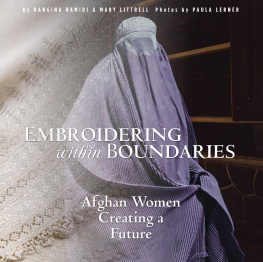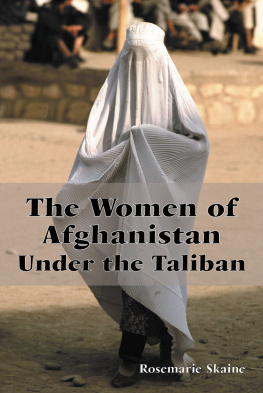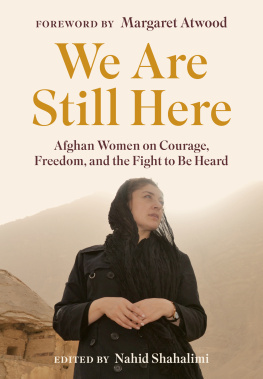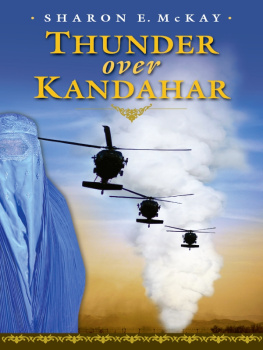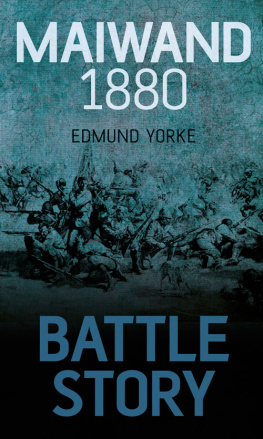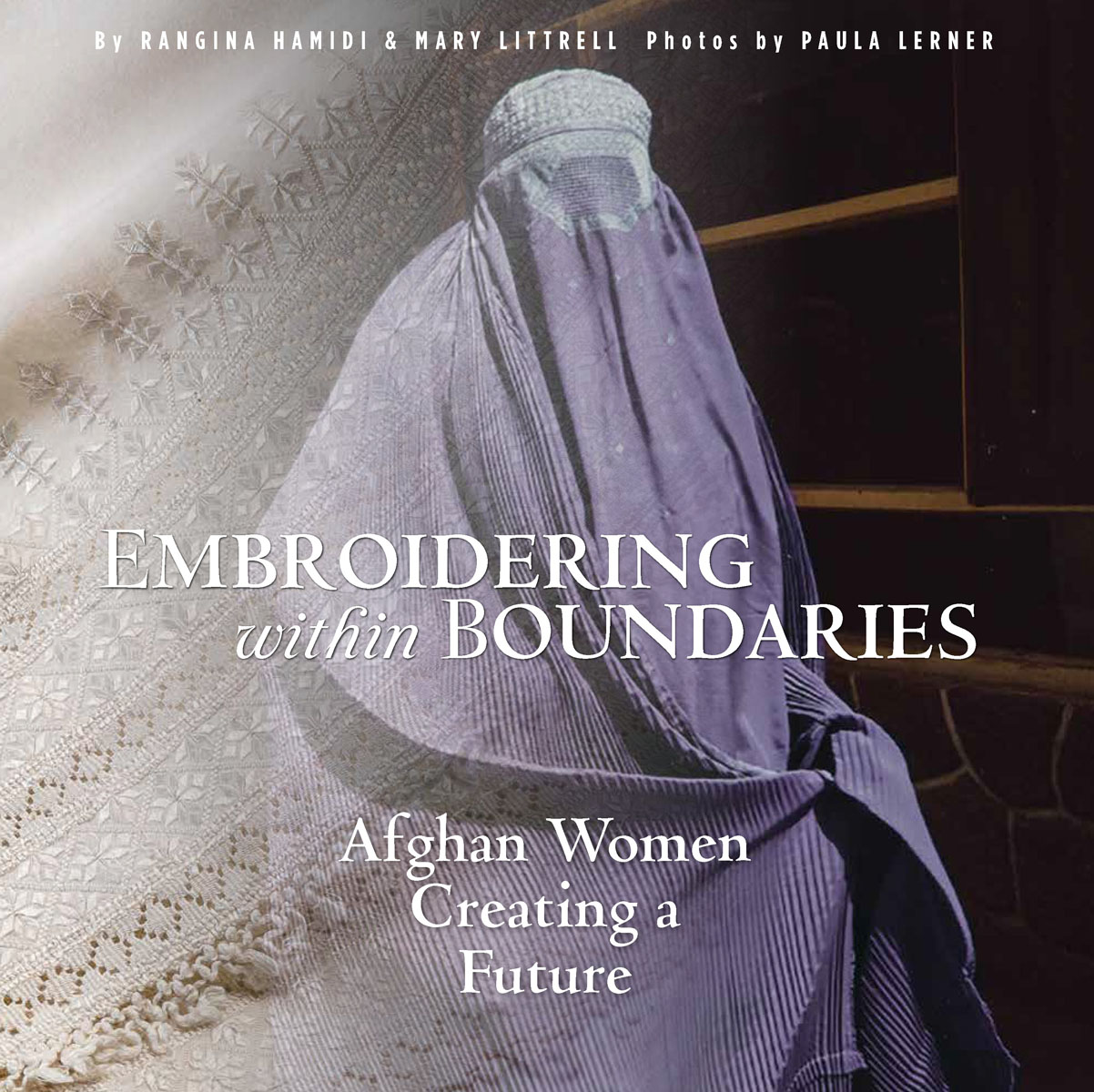

F ifteen years ago, Rangina Hamidi made the decision to dedicate her life to helping rebuild her native Kandahar, Afghanistan. The Taliban had been driven out by American forces following 9/11, but Kandahar was a shambles. Tens of thousands of women, widowed by years of conflict, struggled to support themselves and their families.
Ranginas decision was to start an entrepreneurial enterprise, using the exquisite traditional embroidery of Kandahar, to help women work within the cultural boundaries of Pashtunwali to earn their living and to find a degree of self-determination. Thus Kandahar Treasure was born.
This book, written with global scholar Mary Littrell, traces the converging paths of traditional khamak embroidery, the 400 brave women who have found in it a way to build their lives, and the tenuous state of their efforts as the fate of Kandahar hangs in the balance.
The late, award-winning photojournalist Paula Lerner was dedicated to telling the stories of women in Afghanistan. Her remarkable images throughout the book show Afghan womens profound struggle, strength, and beauty.
Editor/Publisher: Linda Ligon
Associate Publisher: Karen Brock
Design: Susan Wasinger
Text 2017 Rangina Hamidi and Mary Littrell
Photography, except as noted Paula Lerner
Image rights are managed by Aurora Photos (www.auroraphotos.com); any future use of the photographs for commercial purposes must be cleared and licensed from Aurora. The photographs are available for educational and scholarly purposes at the Harvard archives (www.radcliffe.harvard.edu/schlesinger-library).

306 North Washington Avenue
Loveland, Colorado 80537
USA
Printed in China by Asia Pacific
Library of Congress Control Number 2017933269
For our fathers, Ghulam H. Hamidi and Herbert H. Bishop, who encouraged and supported our education.
Acknowledgments
T he International Folk Art Alliance (IFAA), based in Santa Fe, New Mexico, has played an important role in our lives. We are grateful to CEO Jeff Snell, his leadership team, and the IFAA Board of Directors for their work toward celebrating and preserving living folk arts around the world. Together with artists, IFAA is creating economic opportunities and laying the groundwork for artists to serve as catalysts for social change in their communities. In particular, we thank Judy Espinar, a co-founder of the International Folk Art Market-Santa Fe, for her longtime support of Kandahar Treasure and for her encouragement in telling the story of Kandahar Treasure.
From RANGINA
The birth of Kandahar Treasure would not have been possible without guidance provided by Project Artemis at Arizona State Universitys Thunderbird School of Global Management and Business Council for Peace (BPeace). The foundation of Kandahar Treasure is built on business training provided by both institutions whose knowledge, support, and commitment transformed a dream into a reality.
A special thanks to Catherine Shimony, co-founder of Global Goods Partners, who shares my passion for women and crafts around the world. She not only carries our unique products to sell online but continues to provide advice and practical ideas to sustain and support Kandahar Treasure, helping us to produce new and competitive products for the handmade market.
I would like to thank my co-author Mary Littrell who graciously offered to write our storymany people had heard our story; she chose to write it! Thanks also to all of my colleagues in Kandahar who work under dire conditions to make Kandahar Treasure a success. Without their commitment and hard work, we would not have this book today. To Toni Maloney of BPeace for helping me craft the name Kandahar Treasure and to Athena Katsaros and Kate Buggeln for wanting to be my mentors and for becoming my friends. To Kellie Kreiser who continues to be the angel that Kandahar Treasure needs to make new connections and to become involved in new opportunities. To Nadia Aman and Palwasha Lena Kakar for their belief and unending support to me and to Kandahar Treasure.
I am who I am because of my loving family. My caring parents and my amazing sisters and soulmates, Farida, Wazma, Stoorai, and Zarmina, have cleared all boundaries for me. You have always been there for me and have enabled me to reach my dreams in ways unimaginable to many other young Afghan women. I am grateful for having you all in my life.
Finally, to my husband Abdullah and to my daughter Zara, for their love, patience, and understanding for my busy traveling life and for my commitment to working wee hours into the night to make Kandahar Treasure a success. I know that I have compromised a lot of our time together. Your love and your unending support and understanding enable me to do the good that I can in this world. Thank you.
From MARY
As this writing project evolved, a number of colleagues came forward to offer their encouragement for telling the Afghan embroiderers story. These individuals with common interests in global textiles included Judi Arndt, Linda Carlson, Mary Lynn Damhorst, Jana Hawley, Marilyn Murphy, Elena Phipps, Keith Recker, Sylvia Seret, and Clare Smith. My heartfelt thanks go out to each of you.
I am very fortunate to share my life with John Littrell who encourages my work with artisan groups around the world. Even when contemplating a trip to Afghanistan, he trusted that I would make good judgments about travel safety in a country still undergoing political turmoil. As an excellent writer, he willingly reads all that I write and offers excellent critique. This story of women in Kandahar has benefited greatly from his insights and suggestions. Thank you for your collaboration in honoring the work of women in Afghanistan.

TABLE of CONTENTS

PREFACE
Our Writing Journey
S tunned silence hung over the audience as Rangina Hamidi concluded her lecture. Immediately, audience members at the 2014 Textile Society of America Symposium waved their hands to be called upon. Their questions confirmed that they had heard an astonishing story. Rangina had shared the account of how 300 members of Kandahar Treasure, a woman-owned business in war-torn Kandahar, Afghanistan, were bravely crossing cultural boundaries to support and create change for their families. Of pivotal importance to the many-layered storytextiles! Yet Ranginas talk contrasted sharply with news from Afghanistan. Journalists and local observers reported that despite thirty years of war, women still maintained little control over their lives in this deeply patriarchal society.
A final statement from a member of the audience set this book in motion. A woman challenged Rangina, This story of courage has to be told. You have to write a book! Wild applause reinforced the womans request. Rangina responded, Im not a writer. My work is with the women of Kandahar Treasure.
Sitting in the audience that day, I thought of my own work. Over the past thirty-five years, my life as an academic researcher had focused on how artisan enterprises achieved sustainability in an increasingly competitive global market for handmade goods. I had explored factors contributing to organization vitality and chronicled benefits artisans accrued from their participation. While my books and articles offered portraits of best practices in a variety of settings, none centered on artisans who worked under constant fear from wartime violence. Questions arose in my mind about both the women who work on a daily basis at the workshop and about those who work at home and return their finished products intermittently to the office. With their lives in danger, what motivates these women to leave their compounds and walk considerable distances to Kandahar Treasure? How do the women work and prosper in a country where menfolk rule their lives and forbid them to leave their homes unaccompanied? Clearly Kandahar Treasure offered rare and unique insight into the role textiles could play as catalysts for social change in womens lives.
Next page
